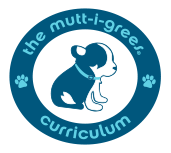We have been learning a lot about each other, and also about dogs. We talked about how dogs and people have some of the same parts (ears, eyes, noses) and some different parts (tail, four legs, paws). Even though people and dogs have some of the same parts, we use them a little differently.
When you meet someone new:
- Do you use your ears to listen to what the person has to say?
- Do you use your eyes to look at the person?
- Do you use your nose to smell the person? Of course not! Dogs experience the world around them differently than people do; dogs begin with their noses, then eyes, then ears. Sniffing gives a dog a lot of information, and it is how dogs can “get to know” people and other dogs. A dog pays more attention to how you smell than how you look! In fact, dogs have several million more sensors in their noses than humans and dogs can smell things that most humans never even notice!
- Can you think of how a dog’s excellent sense of smell could help policemen or firemen? Because dogs’ noses are so good at sniffing and smelling they are often used by policemen and firemen to help find things or people even when these can’t be seen. Dogs have an amazing sense of smell.
- Let’s see how good we are at using our noses… I am going to ask you to close your eyes and see if you can guess what I have in my hand just by smell. Teacher can hold up any fragrant flower, variety of spice, or food and have children try to guess the source of the scent. A dog would be able figure out just what the smell was, as well as smell any other flower or food that’s been in our classroom or even in the school during the past week!

Objective:
Children will consider similarities and differences in how dogs and people experience the world around them. This will help children to take another’s perspective – specifically a dog’s – and subsequently interact with animals with more competence and confidence. Sometimes people humanize dogs and project their feelings onto them. However dogs are not furry four-legged humans – they don’t share the same thoughts and feelings we do. How people feel, act and view the world is different. This lesson helps illustrate the differences between people and dogs.
Vocabulary Words to Highlight:
Experience, Attention, Sense of Smell, Sensors/Sense

